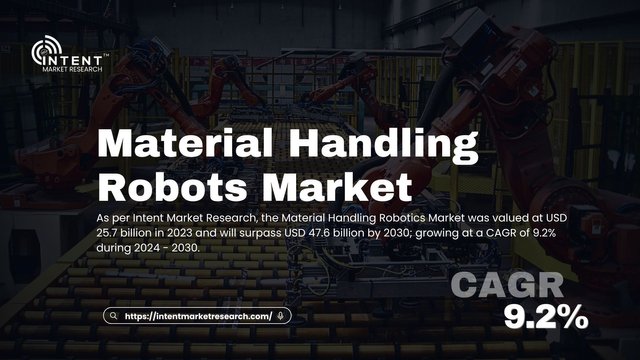
The material handling robotics market is transforming industries globally, revolutionizing the way businesses manage their supply chains and operations. With a valuation of USD 25.7 billion in 2023 and projected to exceed USD 47.6 billion by 2030, this market is growing at a remarkable CAGR of 9.2% from 2024 to 2030. But what’s driving this growth, and what does the future hold for this dynamic sector?
What Are Material Handling Robots?
Material handling robots are specialized machines designed to move, store, and control goods across various industrial settings. They reduce manual labor, improve safety, and boost efficiency in tasks like palletizing, sorting, packaging, and transporting.
Download Sample Report @ https://intentmarketresearch.com/request-sample/material-handling-robotics-market-4290.html
Key Drivers of Market Growth
Demand for Automation: As industries face mounting pressure to streamline operations, robots are increasingly used to automate repetitive and labor-intensive tasks. Automation reduces errors, enhances precision, and saves costs in the long run.
E-commerce Expansion: The e-commerce boom has led to increased demand for faster and more efficient warehousing and order fulfillment processes. Robots play a critical role in meeting these demands.
Labor Shortages: Industries worldwide are grappling with workforce shortages, particularly for manual and repetitive tasks. Material handling robots fill this gap, ensuring business continuity.
Technological Advancements
Artificial Intelligence (AI) Integration: AI enables robots to learn, adapt, and improve their performance over time. From advanced vision systems to predictive maintenance, AI is a game-changer in this field.
Internet of Things (IoT): IoT connectivity allows seamless communication between robots and other devices, creating smart warehouses where operations are monitored and controlled in real-time.
Collaborative Robots (Cobots): Cobots work alongside human workers, enhancing productivity without compromising safety. Their affordability and ease of use make them increasingly popular.
Market Segmentation
By Application
Palletizing and Depalletizing: Widely used in warehouses to stack and unstack goods efficiently.
Packaging: Robots ensure consistent packaging, reducing damage and improving presentation.
Sorting and Picking: Essential in e-commerce and logistics industries for accurate order fulfillment.
By Industry
Manufacturing: Handles raw materials and finished products efficiently.
Retail and E-commerce: Optimizes supply chain operations.
Healthcare: Transports medical supplies and pharmaceuticals safely.
Regional Insights
North America: North America dominates the market, driven by advanced infrastructure and high adoption of automation technologies. The U.S. is a key contributor.
Asia-Pacific: The Asia-Pacific region is witnessing rapid growth due to industrialization and booming e-commerce in countries like China and India.
Europe: Europe remains a leader in robotics innovation, with countries like Germany investing heavily in smart manufacturing solutions.
Challenges in the Material Handling Robotics Market
High Initial Costs: Despite long-term benefits, the initial investment for robots and associated infrastructure can be prohibitive for smaller businesses.
Integration Complexities: Integrating robotics into existing systems can be challenging, requiring expertise and time.
Cybersecurity Concerns: As robots become more connected, they become vulnerable to cyberattacks, posing a risk to sensitive data and operations.
Future Trends
Autonomous Mobile Robots (AMRs): AMRs are gaining popularity due to their flexibility and ability to navigate dynamic environments without human intervention.
Sustainability: Robots designed with energy efficiency and recyclability in mind will appeal to environmentally conscious businesses.
Workforce Upskilling: As robots take over repetitive tasks, there will be a greater focus on upskilling the workforce to manage and maintain these systems.
Access Full Report @ https://intentmarketresearch.com/latest-reports/material-handling-robotics-market-4290.html
Benefits of Material Handling Robotics
Enhanced Productivity
Robots operate 24/7 without fatigue, ensuring consistent output.Improved Safety
By handling hazardous tasks, robots reduce workplace accidents and injuries.Cost Savings
While the initial investment is high, robots lead to significant savings in labor costs and operational efficiency.
FAQs
What industries benefit the most from material handling robots?
Manufacturing, e-commerce, healthcare, and retail are among the industries that see the greatest benefits from material handling robots.Are material handling robots expensive?
While the initial costs can be high, the long-term savings in labor and increased efficiency make them a worthwhile investment.How do robots improve workplace safety?
Robots handle dangerous and repetitive tasks, reducing the risk of human injury and creating safer working conditions.What is the role of AI in material handling robots?
AI allows robots to adapt, optimize operations, and provide predictive analytics for better decision-making.What challenges do businesses face when adopting robotics?
Challenges include high upfront costs, integration issues, and cybersecurity risks.
About Us
Intent Market Research (IMR) is dedicated to delivering distinctive market insights, focusing on the sustainable and inclusive growth of our clients. We provide in-depth market research reports and consulting services, empowering businesses to make informed, data-driven decisions.
Our market intelligence reports are grounded in factual and relevant insights across various industries, including chemicals & materials, healthcare, food & beverage, automotive & transportation, energy & power, packaging, industrial equipment, building & construction, aerospace & defense, and semiconductor & electronics, among others.
We adopt a highly collaborative approach, partnering closely with clients to drive transformative changes that benefit all stakeholders. With a strong commitment to innovation, we aim to help businesses expand, build sustainable advantages, and create meaningful, positive impacts.
Contact Us
US: +1 463-583-2713